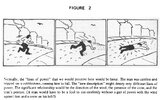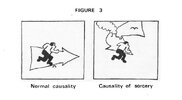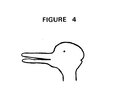To add to the above - some clues by the Cs about brain hemispheres:
So it seems part of the process is tuning your proteins (presumably via knowledge, research, thinking, cleaning up the body and emotions, etc.) which then connects you to the higher type of information. But you also must bring your right and left brain hemispheres into harmony/alignment, because otherwise they fight over the information: the left hemisphere over-thinking, over-abstracting, and chopping everything up into tidy bits and pieces, obsessed with pinning down The Truth once and for all. The right hemisphere absorbing the totality of information and going off into "we are all one", "love and light" and "just listen to your spiritual heart, man!" territory.
This would explain why psychedelics can have such a profound effect on some people: it basically blasts your right hemisphere open, connecting you to the cosmos in that sort of semi-rational way, and you go all "unite! love! I've seen the light! Halleluja!" But it bypasses the realm of rational thought, effort, knowledge, understanding and so on. Hence some people simply go bonkers after that, while for others, it might be beneficial: it sort of re-balances the hemispheres by blasting the right hemisphere open, which might have been dormant. After that, once you go back to the "here and now", you might be better able to receive the cosmic information in a more balanced way, combining the earthly with the spiritual, using the former as a springboard to the latter. Because to read the "geometric language", you must engage both hemispheres simultaneously and in harmony.
With regard to
That's very interesting in light of this sort of "higher geometric language". We know that sounds can have meaning themselves (the sounds that make up languages are not arbitrary). In fact, when learning a language, you can often dimly discern meanings just by the sound of certain words and phrases. So it seems that those "geometric forms" are not only part of the thought world (telepathic) and discernible there, but also part of the world of sound.
(Joe) The question is, before the Fall, was the human brain divided into two hemispheres?
(L) Well, the brain has got two hemispheres no matter what.
(Chu) I think what you said on The Wave was that they were way better connected back then, and that after the Fall, they became lateralized.
A: Exactly. There was always a division in function.
Q: (L) But it was more connected and integrated before the Fall?
A: Yes.
Q: (Ze Germans) Was telepathy how people communicated before the Fall?
A: Partly. But there were "sounds" emitted both by individuals in 4D as well as objects.
(Luc) Iain McGilchrist's work had a big impact on me, so I was wondering: What, if anything, have the left and right brain hemispheres to do with our uplink to the information field and the higher realms?
A: They interpret in tandem the information received by full body sensing.
Q: (L) Left and right brain interpret the information sensed by the full body sensing system...
(Joe) Proteins.
(L) Yeah, all your proteins and your antennas...
(Joe) And your left hemisphere and your right hemisphere fight over it.
(Andromeda) Probably overinterpreting it.
(L) And the uplink to the whole thing is, what, your pituitary?
A: Yes
So it seems part of the process is tuning your proteins (presumably via knowledge, research, thinking, cleaning up the body and emotions, etc.) which then connects you to the higher type of information. But you also must bring your right and left brain hemispheres into harmony/alignment, because otherwise they fight over the information: the left hemisphere over-thinking, over-abstracting, and chopping everything up into tidy bits and pieces, obsessed with pinning down The Truth once and for all. The right hemisphere absorbing the totality of information and going off into "we are all one", "love and light" and "just listen to your spiritual heart, man!" territory.
This would explain why psychedelics can have such a profound effect on some people: it basically blasts your right hemisphere open, connecting you to the cosmos in that sort of semi-rational way, and you go all "unite! love! I've seen the light! Halleluja!" But it bypasses the realm of rational thought, effort, knowledge, understanding and so on. Hence some people simply go bonkers after that, while for others, it might be beneficial: it sort of re-balances the hemispheres by blasting the right hemisphere open, which might have been dormant. After that, once you go back to the "here and now", you might be better able to receive the cosmic information in a more balanced way, combining the earthly with the spiritual, using the former as a springboard to the latter. Because to read the "geometric language", you must engage both hemispheres simultaneously and in harmony.
With regard to
Q: (Ze Germans) Was telepathy how people communicated before the Fall?
A: Partly. But there were "sounds" emitted both by individuals in 4D as well as objects.
That's very interesting in light of this sort of "higher geometric language". We know that sounds can have meaning themselves (the sounds that make up languages are not arbitrary). In fact, when learning a language, you can often dimly discern meanings just by the sound of certain words and phrases. So it seems that those "geometric forms" are not only part of the thought world (telepathic) and discernible there, but also part of the world of sound.


 Maybe that's part of the problem we're running into. We can use the left hemisphere to try to pin down the precise nature of information and consciousness, but we always eventually run up against a brick wall it seems.
Maybe that's part of the problem we're running into. We can use the left hemisphere to try to pin down the precise nature of information and consciousness, but we always eventually run up against a brick wall it seems.




